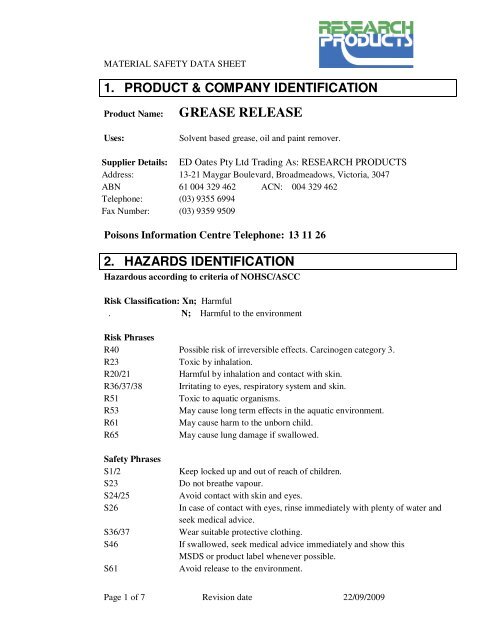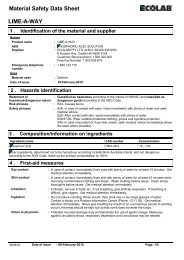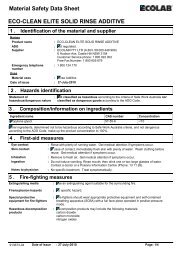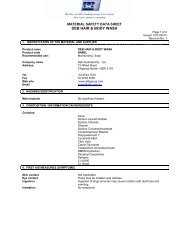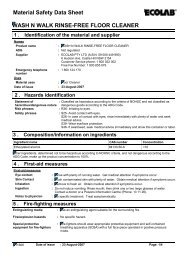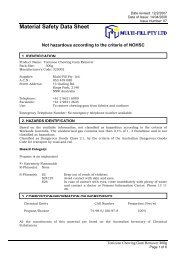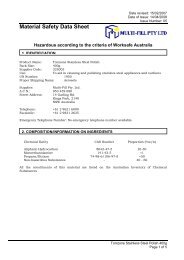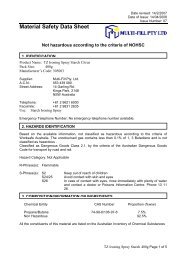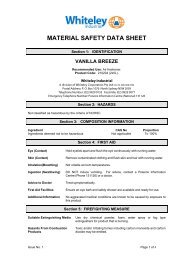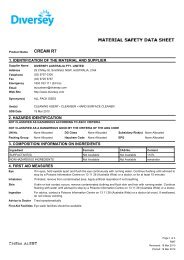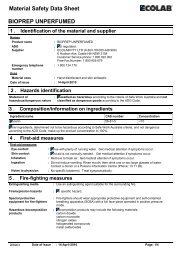Research - Greaserelease - msds - Exp Sep 2014.pdf
Research - Greaserelease - msds - Exp Sep 2014.pdf
Research - Greaserelease - msds - Exp Sep 2014.pdf
You also want an ePaper? Increase the reach of your titles
YUMPU automatically turns print PDFs into web optimized ePapers that Google loves.
GREASE RELEASEincendiary discharge. Toxic vapours and gases such as hydrogen chloride, phosgene, chlorinegas and carbon monoxide are generated when this product is involved in a fire.6. ACCIDENTAL RELEASE MEASURESPersonal precautions:Use personal protective equipment.Keep people away from and upwind of spill/leak.Material can create slippery conditions.Environmental precautions:CAUTION: Keep spills and cleaning runoff out of drains and open bodies of water.Methods & Materials for Containment & Clean Up:Contain spills immediately with inert absorbent materials (e.g. sand, earth).Transfer liquids and used absorbent material to separate suitable containers for recovery ordisposal.7. HANDLING & STORAGEHandling:Ensure that eye bath is available and ready for use. Avoid contact with eyes, skin and clothing.Wash thoroughly after handling. Keep container tightly closed. Do not breathe vapours, mist orfumes. Observe good hygiene practices and recommended procedures. Wash hands thoroughlyafter use, especially before eating or smoking.Conditions for safe storageStore in a cool, dry, well-ventilated area. Keep container tightly closed and locked up when notin use. Store away from sources of ignition and materials such strong oxidizing agents. Do notstore near food stuffs.8. EXPOSURE CONTROLS / PERSONAL PROTECTION<strong>Exp</strong>osure limit(s): There is no exposure data for this product. The <strong>Exp</strong>osure Standards for:2- Butoxy ethanol cas no: 111-76-2;TWA: 20ppm (96.9mg/m 3 ) STEL: 50ppm (242mg/m 3 )Tetrachloro ethylene cas no. 127-18-4TWA: 50ppm (340mg/ m 3 ) STEL: 150ppm (1020mg/m 3 )Xylene cas no. 1330-20-7/100-41-4TWA: 80ppm (350mg/ m 3 ) STEL: 150ppm (655mg/m 3 )White Spirits Un. No. 1300TWA: 70ppm (350mg/ m 3 ) STEL: 150ppm (655mg/m 3 )Absorption through skin may be a significant source of exposure.Page 3 of 7 Revision date 22/09/2009
GREASE RELEASE<strong>Exp</strong>osure controls:Eye protection: Wear safety glasses with side-shields.Hand protection: Wear impervious gloves such as nitrile rubber.Respiratory protection: In case of insufficient ventilation, wear suitable respiratoryequipment.Engineering measures: Use only in a well ventilated area. If handling large amounts asystem of local and/or general exhaust is recommended.9. PHYSICAL & CHEMICAL PROPERTIESPhysical state:LiquidColour:ColourlessOdour:SolventpH:Not ApplicableBoiling point/range:Not establishedMelting point/range:Not applicableFlash point:19- 30 o CLower explosion limit:Not applicableUpper explosion limit:Not applicableVapour pressure:Not establishedRelative vapour density:Not establishedWater solubility:Miscible with water at all proportionsRelative density: 0.895Viscosity, dynamic:Not applicableEvaporation rate:Not establishedPercent volatility:Not determinedNOTE: The physical data presented above are typical values and should not be construed as aspecification.10. STABILITY & REACTIVITYHazardous Reactions:Materials to avoid:Polymerization:Product is stable under normal conditions of use,storage and temperature.Oxidizing agents, halogens and strong acids.Product will not undergo polymerization.Page 4 of 7 Revision date 22/09/2009
11. TOXICOLOGICAL INFORMATIONGREASE RELEASENo data is available for this material.Toxicity DataThis product is classified as harmful if swallowed. May be harmful by inhalation.Health Effects – AcuteSwallowedHarmful if swallowed. Ingestion may cause irritation of mucous membranes in mouth,pharynx, oesophagus and gastro-intestinal tracts. Symptoms include nausea, headache,vomiting, ataxia (impaired locomotor co-ordination), acidosis, drowsiness,Agitation, insomnia, changes in the blood picture, pulmonary oedema and damage to the liverand kidneys.EyeCauses eye irritation.SkinIrritating to skin. Danger of skin absorption. De-fatting of skin can cause drying, cracking anddermatitis.InhaledInhalation causes irritation to the mucus membranes, coughing and dyspnoea. Chronicexposure causes damage to blood cells and blood in urine. Vapour concentration aboveexposure limits (TWA) may cause headaches, drowsiness and dizziness, could be anaestheticand may have other central nervous system effects.12. ECOLOGICAL INFORMATIONEcotoxicity: No data availablePersistence and degradability: No information available for this product.Mobility: No information available on this product.Environmental fate (exposure): Avoid contaminating waterways, drains and sewers.Bioaccumulative potential: No information available for this product.Page 5 of 7 Revision date 22/09/2009
13. DISPOSAL CONSIDERATIONSGREASE RELEASEEnvironmental precautions: CAUTION: Keep spills and cleaning runoff out of municipalsewers and open bodies of water.Disposal: Dispose of in accordance with local, state and federal regulations.14. TRANSPORT INFORMATIONUN Number: 1992UN Proper Shipping Name: PETROLEUM PRODUCTS N.O.S.Class : DG Class 3Subsidiary Risk: 6.1Packing Group: IIISpecial Precautions for User: Avoid storage or contact with strong oxidising or reducingagents.Hazchem Code: 3[Y]15. REGULATORY INFORMATIONLabelClassification and labelling have been performed according to regulations.Poison Schedule 6EPGPETROLEUM PRODUCTS N.O.S.Australia. Industrial Chemical (Notification and Assessment) Act (AUSTR). Allingredients in this preparation are listed in the Australian Inventory of Chemical Substances,AICS.16. OTHER INFORMATIONDate of Preparation: 08.08.2008Key to Abbreviations & Acronyms Used in MSDS:< Less Than> Greater ThanAICS Australian Inventory of Chemical SubstancesCAS Chemical Abstracts Service (Registry Number)LC50 LC stands for lethal Concentration. LC50 is the concentration of a materialin air which causes death of 50% (one half ) of a group of test animals.LD50 LD stands for “Lethal Dose”. LD50 is the amount of a material, given all atonce, which causes the death of 50% (one half) of a group of test animals.Page 6 of 7 Revision date 22/09/2009
NOHSCOECDPELSTELTLVTWAUNdeg C (‘C)gg/cm3g/lImmisciblekgkg/m3ltrm3mgmg/24Hmg/kgmg/m3miscibleppmwtGREASE RELEASENational Occupational Health and Safety Commission.Organisation for Economic Co-operation and Development.Permissible <strong>Exp</strong>osure Limit.Short Term <strong>Exp</strong>osure LimitThreshold Limit ValueTime Weighted AverageUnited Nations (Number)Degrees CelsiusGramGrams per cubic centimetreGrams per litreLiquids are insoluble in each otherKilogramKilograms per cubic metreLitreCubic metreMilligramMilligrams per 24 hoursMilligrams per kilogramMilligrams per cubic metreLiquids form one homogeneous liquidParts per millionWeightLiterature References: Supplies MSDSThe information provided in this Safety Data Sheet is correct to the best of our knowledge,information and belief at the date of its publication. The information given is designed only asguidance for safe handling, use, processing, storage, transportation, disposal and release and isnot to be considered a warranty or quality specification. The information relates only to thespecific material designated and may not be valid for such material used in combination withany other materials or in any process, unless specified in the text.Uncontrolled document. Please ensure you have the current copy.Version 7.2Revision date: 22.09.2009Print date: 10/09/10Page 7 of 7 Revision date 22/09/2009


